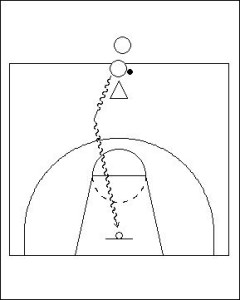The Gate Drill
The Gate Drill is a favourite activity of Functional Basketball Coaching. The Gate Drill demands players compete in a one on one situation, but are limited in their scope of movement and offensive objective. The Gate Drill forces players to utilise the room they have when using the ball to score without being wasteful by over dribbling. Great for young players and older athletes the Gate Drill is a fantastic starting point for players to utilise their individual offensive skills while becoming competent under pressure.
There are a few points that need to emphasised when utilising the Gate Drill.
Most players fail to look at the defender in front of them. Many players decide upon what action they will be taking prior to even starting their initial movement. A coach will need to explain to players what signs they are looking for in the defender in front of them. For example if a defender falls for a fake, what should the offensive player do to maximise the advantage and scoring potential.
Use one or two fakes to draw a response from the opponent. Many offensive players tend to over utilise their fakes and jabs to try and draw a response from the defender. The offensive player must learn to slow down their fakes to give the defender time to respond and then make the read on what to do. By doing this the offensive player will be able to use less fakes or jabs to achieve the desired response or situation.
Attack the hip of the defender. Because of the limited space, the Gate Drill forces players to work off the hip of the defender in front of them. Once past this point the offensive player will then adjust to attack the basket in the most direct line. This will limit the opportunity for the defender to recover. It is only natural at the start of undertaking this teaching point for players to find this technique awkward and challenging, but with time this one aspect is worth an extra two steps of distance alone.

Players line-up at halfway line. The first player in the line assumes the role of defender. The second player in the line is the offensive player.
Players must get by their defender and pass between the elbows of the foul circle to score.
The defender starts with the ball. Once this player is in position they will hand the ball to the offensive player.
Once the offensive player has the ball the Gate Drill becomes “live”.
Variation:
Limit amount of dribbles the offensive player can take. This will add some additional pressure to the offensive player to utilise their dribbles more effectively. The Gate Drill in this way can be a very effective way in helping a player who tends to over dribble the ball to reduce this excess and become more efficient.
Another nice option that can be incorporated in the Gate Drill is to have players pass ball to coach and then have to cut to basket by passing through the gate. This is a very effective strategy for helping players make a read about the defender in front of them and choose which lane to cut down to the basket.
When using this variation speak with offensive players about creating a lead for the ball. During this movement, the offensive player will decide to either cut ball side or weak side of the defender.
If cutting weak side the most useful tool for the offensive player will be rapid acceleration to try and out run the defender. This is by far the most risky option though and one that is most difficult for the passer to be able to judge if it is going to be a good option or not.
Cutting ball side however is more than likely the more desired option when cutting to the basket.
The Gate Drill can be a very useful drill in having players exposed to the challenges of one on one play, but also supports the defence by forcing the offensive player to enter a small section of the floor. In many ways, the Gate Drill replicates the use of space in the half court while avoiding help defence triggers and rotations. This makes the Gate Drill very versatile in helping players not only become competent in creating their own shot, but also becoming better at reading the defender in front of them.








Leave a Reply